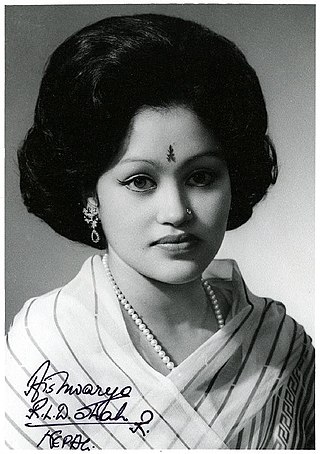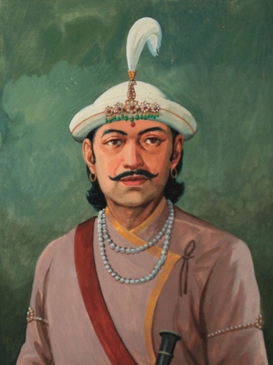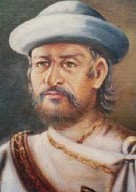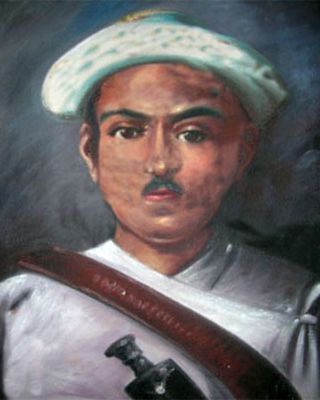
The Kingdom of Nepal was a Hindu kingdom in South Asia, formed in 1768 by the expansion of the Gorkha Kingdom, which lasted until 2008 when the kingdom became the Federal Democratic Republic of Nepal. It was also known as the Gorkha Empire, or sometimes Asal Hindustan. Founded by King Prithvi Narayan Shah, a Gorkha monarch who claimed to be of Khas Thakuri origin, it existed for 240 years until the abolition of the Nepalese monarchy in 2008. During this period, Nepal was formally under the rule of the Shah dynasty, which exercised varying degrees of power during the kingdom's existence.

Maharajadhiraj Prithvi Narayan Shah, , was the last king of the Gorkha Kingdom and first king of the Kingdom of Nepal. Prithvi Narayan Shah started the unification of Nepal.

The Gorkha Kingdom was a member of the Chaubisi rajya, a confederation of 24 states, located at the intersection of Himalayas and the Indian subcontinent. In 1743 CE, the kingdom began a campaign of military expansion, annexing several neighbors and becoming present-day Nepal. The Gorkha Kingdom extended to the Marshyangdi River in the west, forming its border with the Kingdom of Lamjung. To the east, the kingdom extended to the Trishuli River, forming its border with the Nepal Mandala. The Gorkha Kingdom was established in 1559 CE by Prince Dravya Shah, the second son of King Yasho Brahma Shah of Lamjung. The prince replaced the King Mansingh Khadka Magar who previously ruled the region.

Aishwarya Rajya Lakshmi Devi Shah was the Queen of Nepal from 1972 to 2001, also referred to as Bada Maharani (बडामहारानी). She was the wife of King Birendra and the mother of King Dipendra, Prince Nirajan, and Princess Shruti. She was the eldest among the three daughters of the late General Kendra Shumsher Jang Bahadur Rana and Shree Rajya Lakshmi Devi Shah in Lazimpat Durbar, Lazimpat, Kathmandu.

The Shah dynasty, also known as the Shahs of Gorkha or the Royal House of Gorkha, was the ruling Chaubise Thakuri Rajput dynasty and the founder of the Gorkha Kingdom from 1559 to 1768 and later the unified Kingdom of Nepal from 1768 to 28 May 2008.

The unification of Nepal was the process of building the modern Nepalese state, from fractured petty kingdoms including the Baise Rajya and the Chaubisi Rajya, which began in 1743 AD. The prominent figure in the unification campaign was Prithvi Narayan Shah, King of Gorkha. On 25 September 1768, he officially announced the creation of the Kingdom of Nepal and moved his capital from Gorkha to the city of Kathmandu.

Nara Bhupal Shah was a king of the Gorkha Kingdom, which lies in modern day Nepal; and the father of Prithvi Narayan Shah. Nara Bhupal Shah was the son of Birbhadra Shah, the grandson of Prithvipati Shah. He was the king of the Gorkha state in Nepal. He unsuccessfully tried to extend his kingdom by capturing Nuwakot.
Himani, Former Crown Princess of Nepal is the wife of the former heir apparent to the throne of Nepal, Crown Prince Paras.

Basnyat/Basnet family or Basnyat/Basnet dynasty was a Khas-Chhetri and a warlord clan family involved in the politics and administration of the Gorkha Kingdom and Kingdom of Nepal. This family got entry into Thar Ghar aristocracy group of Gorkha at the time of King Prithvi Narayan Shah. It was one of the four noble families to be involved in active politics of Nepal together with Shah dynasty, Pande family and Thapa dynasty before the rise of Rana dynasty. This family is descended from Shivaram Singh Basnyat, the commander of Gorkhali forces and a member of Shreepali Basnyat clan of Gorkha. This family was maritally linked to Kala (Black) Pande section of Pande dynasty through Chitravati Pande who married Kaji Kehar Singh Basnyat. This family was the last Kshatriya (Chhetri) political family to be wiped out from the central power by Jung Bahadur Rana of Kunwar family during the Bhandarkhal Massacre in 1846 for the conspiracy to take the power leading to people suffering from the Rana rule for 104 long years.

The Narayanhiti Palace Museum is a public museum in Kathmandu, Nepal located east of the Kaiser Mahal and next to Thamel. The museum was created in 2008 from the complex of the former Narayanhiti Palace following the 2006 revolution. Before the revolution, the palace was the residence and principal workplace of the monarch of the Kingdom of Nepal, and hosted occasions of state.
Prince Dhirendra Bir Bikram Shah Dev of Nepal was the youngest son of King Mahendra of Nepal and his first wife, Crown Princess Indra.

The King of Nepal (traditionally known as the Mahārājdhirāja i.e. Great King of Kings; it can also be translated as "Sovereign Emperor" was Nepal's head of state and monarch from 1768 to 2008. He served as the head of the Nepalese monarchy—Shah Dynasty. The monarchy was abolished on 28 May 2008 by the 1st Constituent Assembly. The subnational monarchies in Mustang, Bajhang, Salyan, and Jajarkot were abolished in October of the same year.
Maharaj Adhirajkumar Chandrarup Shah was the youngest son of Prithvipati Shah and Rani Kulangavati. He is known in the history of Nepal for cleverly settling power struggle in the Royal house of Gorkha between Dal Shah and Udyot Shah after the death of their older brother Birbhadra Shah. Chandrarup Shah was appointed as the Regent for his nephew Maharaj Nara Bhupal Shah

Kaji Biraj Thapa Magar played an important role in the Gorkha Kingdom. His leadership, prudence and courage all exhibit that he was one of the important Gorkha Bhardars that helped Narbaupal Shah become King of Gorkha. He may also be seen as a King Maker in the modern day term. According to different genealogies, he had taken Narabhupal Shah and his mother Malikavati in custody for three months. The Queen Mother and her son were secretly protected at his residence. After the death of his grandfather, Narabhupal Shah became the King of Gorkha in 1716 and died in 1743. His son, King Prithvi Narayan Shah, succeeding him began unification of small principalities to found modern Nepal.
General Prince Narendra Bikram Shah was the second son of King Surendra of Nepal. The prince was exiled to India because of his involvement in a conspiracy against the Rana dynasty.
Ganesh Pandey or Ganesa Pande
Bir Bhadra Thapa or Birabhadra Thapa also spelled Virabhadra or Virbhadra, was a politician, courtier and military officer in the Gorkha Kingdom during the 18th century. Born in the medieval Tanahun Kingdom, he left his ancestral property there and migrated to the uprising Gorkha Kingdom. He got entry into the minor ranks of military of King Prithvi Narayan Shah due to being a nephew of Sura Prabha, the wife of military commander Shivaram Singh Basnyat of the Basnyat dynasty. Thereafter, he took part in the various battles of Unification of Nepal throughout his life. Among his grandsons, Bhimsen Thapa went on to become the Mukhtiyar of Nepal for 31 years and founder of Thapa dynasty.

The Pande family or Pande dynasty was a Rajput-Chhetri political family that directly ruled Nepali administration affairs from the 16th century to 19th century as Mulkaji and Mukhtiyar. This dynasty/family was one of the four noble families to be involved in active politics of Nepal together with Shah dynasty, Basnyat family and Thapa dynasty before rise of Rana dynasty. Pande dynasty is the oldest noble family to hold the title of Kaji. This family was decimated from political power in 1843 CE in the political massacre by Prime Minister Mathabar Singh Thapa as a revenge for his uncle Bhimsen's death in 1839.
Swarup Singh Karki or Swaroop Singh Karki, was a Nepali politician, courtier, military commander and minister. He was popular for his singing prowess and court conspiracies. He was selected as Dewan in the reign of King Pratap Singh Shah and a significant politician in the regent rule of Queen Rajendra of Nepal. He was one of the most influential court politician in the rule of King Pratap Singh and Queen Rajendralaxmi others being his rival Bahadur Shah of Nepal and Vamsharaj Pande. Vamsharaj was his perceived career rival. His life and career ended when Prince Bahadur Shah was appointed as regent in 1785.











